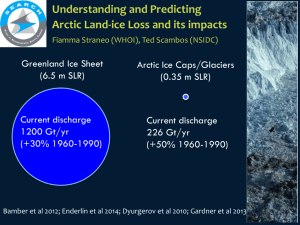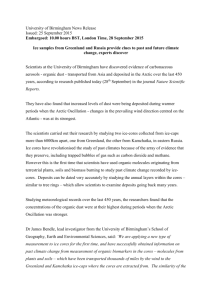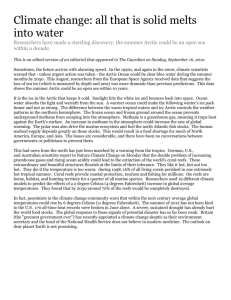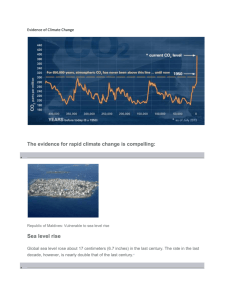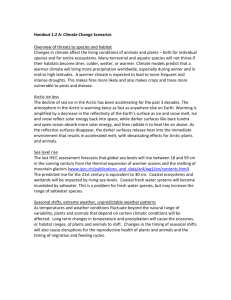latest blog
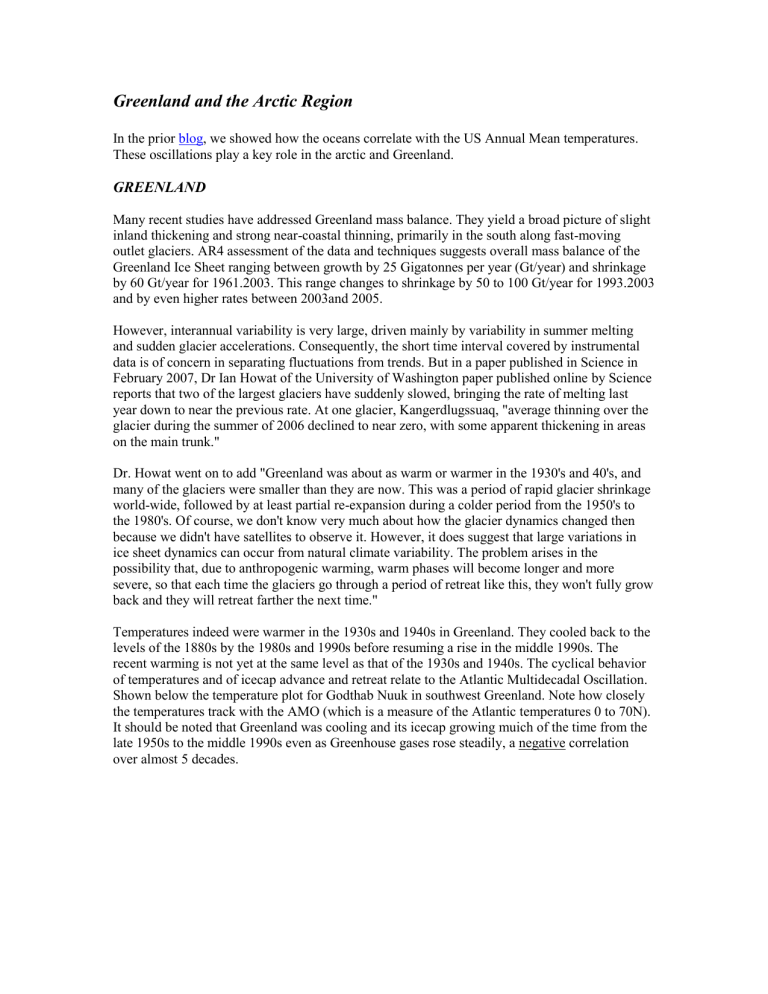
Greenland and the Arctic Region
In the prior blog , we showed how the oceans correlate with the US Annual Mean temperatures.
These oscillations play a key role in the arctic and Greenland.
GREENLAND
Many recent studies have addressed Greenland mass balance. They yield a broad picture of slight inland thickening and strong near-coastal thinning, primarily in the south along fast-moving outlet glaciers. AR4 assessment of the data and techniques suggests overall mass balance of the
Greenland Ice Sheet ranging between growth by 25 Gigatonnes per year (Gt/year) and shrinkage by 60 Gt/year for 1961.2003. This range changes to shrinkage by 50 to 100 Gt/year for 1993.2003 and by even higher rates between 2003and 2005.
However, interannual variability is very large, driven mainly by variability in summer melting and sudden glacier accelerations. Consequently, the short time interval covered by instrumental data is of concern in separating fluctuations from trends. But in a paper published in Science in
February 2007, Dr Ian Howat of the University of Washington paper published online by Science reports that two of the largest glaciers have suddenly slowed, bringing the rate of melting last year down to near the previous rate. At one glacier, Kangerdlugssuaq, "average thinning over the glacier during the summer of 2006 declined to near zero, with some apparent thickening in areas on the main trunk."
Dr. Howat went on to add "Greenland was about as warm or warmer in the 1930's and 40's, and many of the glaciers were smaller than they are now. This was a period of rapid glacier shrinkage world-wide, followed by at least partial re-expansion during a colder period from the 1950's to the 1980's. Of course, we don't know very much about how the glacier dynamics changed then because we didn't have satellites to observe it. However, it does suggest that large variations in ice sheet dynamics can occur from natural climate variability. The problem arises in the possibility that, due to anthropogenic warming, warm phases will become longer and more severe, so that each time the glaciers go through a period of retreat like this, they won't fully grow back and they will retreat farther the next time."
Temperatures indeed were warmer in the 1930s and 1940s in Greenland. They cooled back to the levels of the 1880s by the 1980s and 1990s before resuming a rise in the middle 1990s. The recent warming is not yet at the same level as that of the 1930s and 1940s. The cyclical behavior of temperatures and of icecap advance and retreat relate to the Atlantic Multidecadal Oscillation.
Shown below the temperature plot for Godthab Nuuk in southwest Greenland. Note how closely the temperatures track with the AMO (which is a measure of the Atlantic temperatures 0 to 70N).
It should be noted that Greenland was cooling and its icecap growing muich of the time from the late 1950s to the middle 1990s even as Greenhouse gases rose steadily, a negative correlation over almost 5 decades.
Figure 1: Godthab Nuuk, Greenland annual mean temperatures (NASA GISS) top and the AMO bottom (annual dark blue and 5 year running mean purple) source CDC Climate Indices
A SIMILAR STORY IN THE ARCTIC
Warming in the arctic is likewise shown to be cyclical in nature. This was acknowledged in the
AR4 which mentioned the prior warming and ice reduction in the 1930s and 1940s. Warming results in part from the reduction of arctic ice extent because of flows of the warm water associated with the warm phases of the PDO and AMO into the arctic from the Bering Straits and the far North Atlantic.
Figure 2: Arctic basin wide temperatures from Polyakov (2003) versus PDO+AMO (STD). Dark blue is annual and purple 5 year running means.
The Japan Agency for Marine-Earth Science and Technology in Yokosuka, Kanagawa Prefecture observed in a story in Yahoo Asia News in 2005 an ice shrinkage in the western Arctic Ocean from 1997 to 1998 that they attributed to “… by the flow to the area of warm water from the
Pacific Ocean, not by atmospheric impact as previously thought”.
This was related to the super
El Nino of 1997/98. JAMSTEC's Koji Shimada, the group's sub-leader, said the shrinkage was particularly severe in the Pacific side of the Arctic Ocean. The ocean's ratio of area covered with ice during the summer stood at about 60-80 percent from the 1980s to mid-1990s, but it went down to 15-30 percent after 1998, he said.
In addition, Dmitrenko and Polyokov (2003) observed warm Atlantic water from the warm AMO had made its way under the ice to off of the arctic coast of Siberia where it thinned the ice by
30% much as it did when it happened in the last warm AMO period from the 1880s to 1930s (rsquared correlation since 1900 of 0.62).
As was the case for US temperatures in the prior blog , the combination of the PDO and AMO
Indexes (PDO+AMO) again has considerable explanatory power for Arctic average temperature, yielding an r-squared of 0.73.
SOLAR CONNECTION ?
As noted in the Icecap All About Climate “Climate Factors” solar story , Soon (2006) showed a strong correlation of the arctic temperatures of Polyakov with the total solar irradiance (r-squared of 0.79). Note how the correlation with the carbon dioxide is weak and not convincing (r-squared of 0.22). This implies a possible role of the sun in the ocean cycles. The ocean cycles seem to be in phase with the solar cycles. Look for more on the solar and a look “down under “at the
Antarctic in upcoming blog stories.
References:
IPCC Fourth Assessment 2007
Kerr, R. A., A North Atlantic climate pacemaker for the centuries,
Science, 288 (5473), 1984-1986, 2000.
Latif, M. and T.P. Barnett, 1994: Causes of decadal climate variability over the North
Pacific and North America. Science 266, 634-637.
Mantua, N, Hare, S.R., Zhang, Y., Wallace, J.M., Franic, R.C.: 1997, A Pacific
Interdecadal Oscillation with impacts on Salmon Production, BAMS vol 78, pp 1069-
1079
Miller, A.J., D.R. Cayan, T.P. Barnett, N.E. Graham and J.M. Oberhuber, 1994: The
1976-77 climate shift of the Pacific Ocean. Oceanography 7, 21-26.
Minobe, S. 1997: A 50-70 year climatic oscillation over the North Pacific and North
America. Geophysical Research Letters, Vol 24, pp 683-686.
Minobe, S. Resonance in bidecadal and pentadecadal climate oscillations over the North
Pacific: Role in climatic regime shifts. Geophys. Res. Lett.26: 855-858.
Polyakov, I., Alekseev, G.V., Timokhov, L.A., Bhatt, U.S., Colony, R.L., Simmons, H.L.,
Walsh, D., Walsh, J.E. and Zakharov, V.F., 2004. Variability of the Intermediate
Atlantic Water of the Arctic Ocean over the Last 100 Years. Journal of Climate 17:
4485-4497.
Soon, W., (2006). "Variable Solar Irradiance as a Plausible Agent for Multidecadal
Variations in the Arctic-Wide Surface Air Temperature Record of the Past 130 years
" GRL, vol 32 ( http.//www.agu.org/pubs/crossref/2005/2005GL023429.shtml
)

